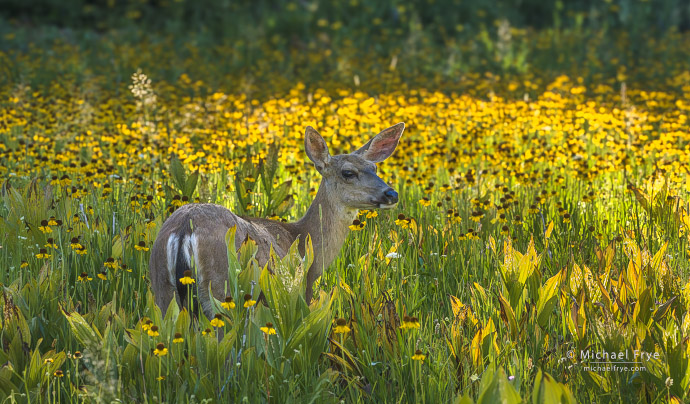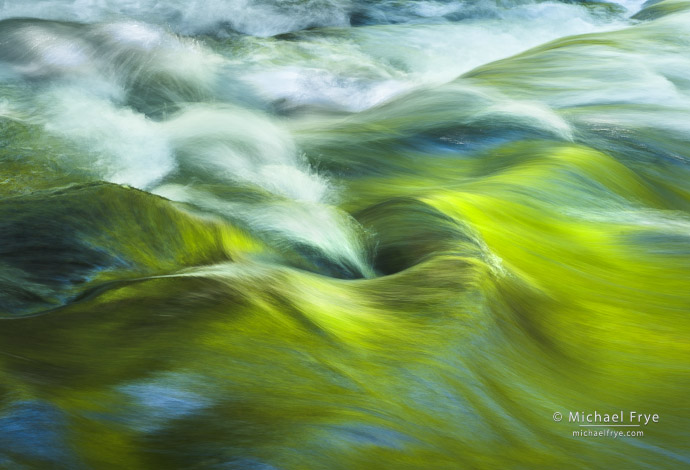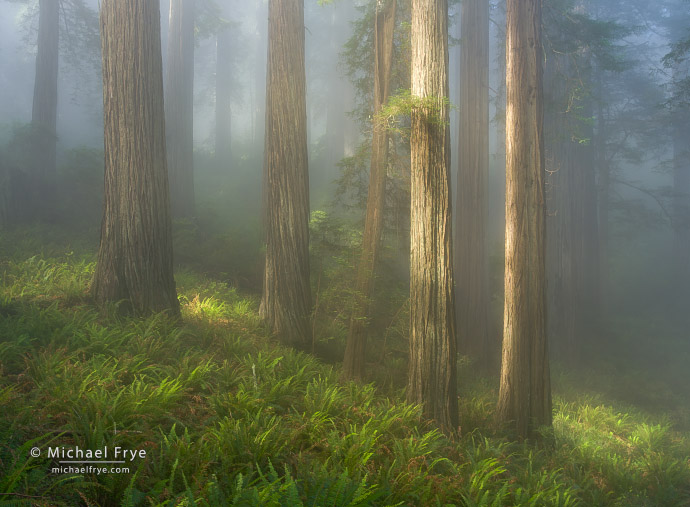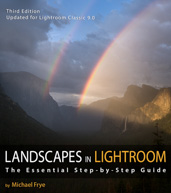Light and Weather
by Michael Frye | Nov 30, 2025 | Light and Weather, Travels and Stories

Waves, fog, and sunbeams along the Oregon Coast. I waited for the sun to crest the ridge on the left and light the large waves rolling in, using a fast shutter speed (1/500 sec.) to freeze the motion. I liked this moment, with sunbeams and a series of wave splashes.
Claudia and I just returned from our annual trip to the Oregon Coast. Our workshop went really well, with a small, wonderful group of participants. And we had some beautiful light to work with.
One of the things I told the group was how much I love the variety of light and moods you can photograph along the Oregon Coast. The weather seems to change constantly (in November at least). One day it’s stormy and dramatic, the next day (or minute) it’s foggy and ethereal. Or something else. With the changeable weather, and the shifting tides and waves, it’s a dynamic environment, where you have to be on your toes to capture moments when the light, weather, and waves come together to create something interesting and beautiful.
Those moments are frequent, but fleeting. You need to anticipate when something might happen, or be able to switch gears quickly when things change.
(more…)
by Michael Frye | Oct 30, 2025 | Light and Weather, Travels and Stories

Dappled light at a canyon overlook, Utah
Claudia and I are finally on our way home after our long road trip. It’s been a fantastic journey, and we really don’t want it to end, but we’ll be back on the road again soon, heading to the Oregon Coast. That’s one of my favorite places to photograph, so I’m looking forward to that already.
I’ve made lots of new images on this trip that I’m excited about. It’ll take some time to sort through and process them all, but here are a few photos from one stormy day in Utah.
(more…)
by Michael Frye | Sep 1, 2025 | Light and Weather

Sunset light, high country, Yosemite NP, California. I made this photo on Monday evening as the sun sank into a gap in the clouds and started to light the peaks.
Subtropical regions of the world experience monsoons every summer. The most famous monsoon occurs over the Indian subcontinent. But North America also gets a monsoon. It’s a complex weather process, but a primary force is the hot summer temperatures over land, which creates a localized low-pressure area, which in turn pulls moisture from the Gulf of California (and, to a lesser extent, the eastern Pacific and Gulf of Mexico) over the deserts of northern Mexico and the southwestern U.S. This monsoonal moisture brings thunderstorms to these regions, especially over higher terrain. While these thunderstorms are usually scattered widely, they can cause intense downpours over local areas, generating flash floods.
Here in central California we’re at the outer limits of the North American monsoon region. Monsoonal moisture typically reaches us for only a few brief stretches each summer, and often only generates showers and thunderstorms over higher elevations as that moisture gets pushed upward, cooling the air and causing the water vapor to condense into clouds and rain.
(more…)
by Michael Frye | Jul 20, 2025 | Light and Weather

Mule deer doe and backlit wildflowers, Yosemite NP, California. 262mm, 1/500 sec. at f/16, ISO 1600.
It’s midsummer, which motivates Claudia and me to seek cooler and less-crowded spots in the Yosemite high country. And there are usually many flowers at those higher elevations this time of year, which gives us another incentive to go up there.
We spent a couple of afternoons recently in some colorful meadows. I loved the way the sunlight filtered through the trees next to these meadows, creating bands of light and dark through patches of flowers.
(more…)
by Michael Frye | Jun 29, 2025 | Light and Weather

Cascade and spring reflections, Great Smoky Mountains NP, Tennessee. I loved the repeating patterns created by the standing waves in this cascade, coupled with the vivid green reflections. 52mm, 1/3 sec. at f/16, ISO 100.
You can find every shade of green in the Smokies in spring – light green, dark green, blue-green, yellow-green, and everything in between. Occasionally the greens are mixed with a splash of blue sky or white water, but it’s a green world.
Our eyes and brains can distinguish more shades of green than any other color. The cones in our retinas, which perceive color, are more sensitive to green wavelengths than other colors – not surprising for a species that evolved in African forests, where distinguishing between shades of green helped find food and avoid predators.
(more…)
by Michael Frye | Jun 15, 2025 | Light and Weather, Vision and Creativity

Sunlight, fog, and redwoods, Northern California
Claudia and I recently returned from two weeks in the far northwest corner of California among the redwoods. And we loved it there, as always. It’s one of my favorite places on the planet.
I love forests in general, including the hardwood forests in the eastern U.S., the conifer forests of Yosemite, aspens in the western mountains, and the moss-draped, old-growth forests of the Olympic Peninsula. They’re all great.
But the redwoods are extra-special to me. Among these giant trees, I feel like I’ve been transported back in time. It’s easy to imagine dinosaurs roaming forests like these – because they did. During the Cretaceous period, the height of the dinosaur’s reign, some 145 to 66 million years ago, ancestors of redwoods were abundant, covering large tracts of the northern and southern hemispheres. If redwood forests seem ancient and primeval to me, it’s because they really are ancient. That earthy smell of redwoods and ferns I notice when I enter a redwood forest was probably familiar to many dinosaurs.
(more…)














